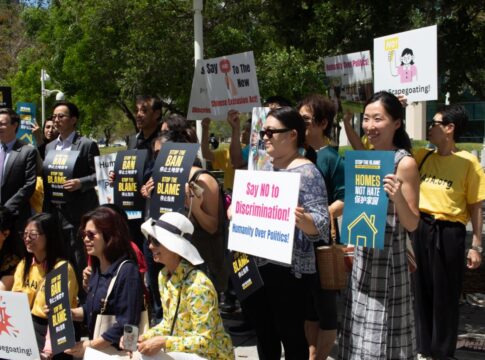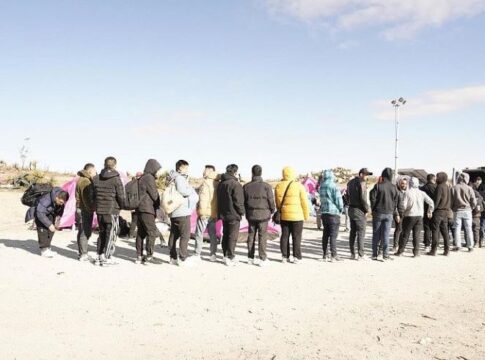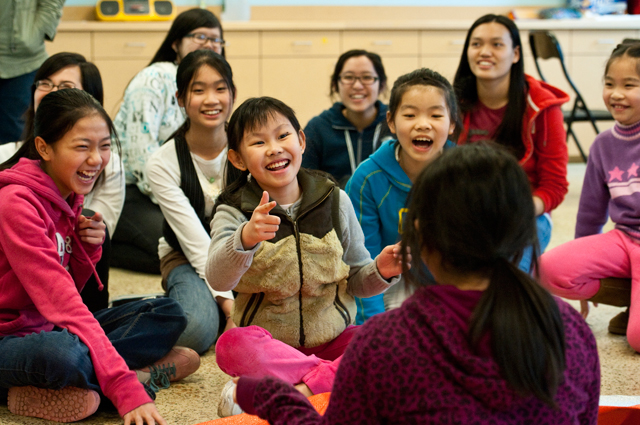
- 14 states already show a minority-majority of under 15-year olds.
- The under-15 population is 50.1% nonwhite
- Today’s white backlash is a result of the shifting demographics
For the first time, non-Hispanic White residents now make up less than half (49.9%) of the nation’s under age 15 population, newly released 2018 U.S. Census Bureau estimates show.
As population trends move away from a White majority, the popular image of what an American looks like will change. For centuries, the default identity of an American has been the White male, followed closely by the White female. We see that identity already changing among the under-15-year-olds, Gen Z.
The new census estimates, coupled with longer term projections, paint a picture of a country with an aging White population that will exist in tandem with rising racially diverse youth, according to the Brookings Institute.
There’s a bit of irony in that the older, majority-White segment of the US will have to depend on the work ethic and earnings of the younger workers of color for their Social Security benefits and security of their pensions.
That bit of news should rile up the White supremacists and widen the divide between Donald Trump’s insecure White supporters fearful of losing what they believe is their god-given right at the top of the heap and the growing diverse demographic seeking a piece of the American Dream.
The new data compiled by Brookings, highlight the increasing racial diversity of the nation’s overall population, for which non-Hispanic Whites now comprise only slightly more than three-fifths (60.4%) of all residents. But the fact that White children under 15 have already become a minority in their age group underlines the factual trend that the nation’s diversity is percolating from the “bottom up” as the White population ages.
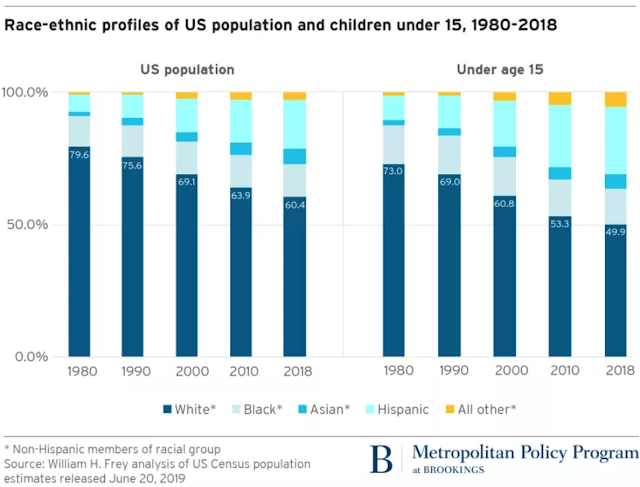
Government workers and nonprofit agencies are already struggling for this demographic. Working in the public sector, I often had to smooth out the interactions between the nonprofits and county agencies adjusting their services to the new clients. The struggle is in part one of funding. In California’s case, the tax dollars are not there because of Proposition 13, which limits the ability to raise taxes in order to provides these services as well as to maintain infrastructure.
LATEST STORIES
This population phenomenon, which is projected to continue, emphasizes the need for institutions that focus on children and young families to proactively accommodate the interests of more racially diverse populations, as the latter will be key players in the country’s demographic and economic future.
Shifts in the nation’s racial/ethnic make-up show smaller shares of Whites since 1980, when African Americans were the most dominant nonwhite group. Since then, especially large gains were made in the Hispanic population, and then later in the Asian population. In the San Francisco Bay Area, for example, Asians are the largest ethnic group in two of the nine-county region and edging up in the other counties.
According to the Brookings Institute, in 2018, for the first time, the combined nonwhite population – Blacks, Hispanics, Asians, persons identifying as multiracial, and other races–comprised the dominant share of the under-15 population (50.1% compared with 49.8% in 2017), with Hispanics accounting for more than a quarter of this youth demographic. This is partially due to the growth of some of the latter populations.
But these trends are also a consequence of declines in the numbers of young Whites as the White population ages. In California, the population shift is hastened by White flight, as Whites move to nearby states like Arizona, Oregon and Nevada, because — well, because they can.
This under age 15 population is part of the Gen Z population, ages 21 and below in 2018, and helps to make this generation (which is 50.9% White) more racially diverse than Millennials (55.1 % White) and Gen Xers (59.7 % White).
Gen Z is also quite distinct, in terms of its race-ethnic profile, from the Baby Boomers and earlier generations, which each exceed 70% White, according to Brookings.
Visible evidence of the growing diversity among youth 15-and-under is more noticeable in some parts of the country than others. Led by Hawaii, where only 14.6 percent of these children are White, the list includes the nation’s four largest states, California, Texas, Florida, and New York. Altogether, 14 states show a minority-majority of under 15-year olds.
Eleven more states, including Illinois, Connecticut, Washington, and Colorado house under age 15 populations where racial/ethnic minorities comprise at least 40% of their residents.
A similar dispersion has taken place among the nation’s 100 largest metropolitan areas, where the under age 15 populations are minority White in 42 metro areas and no more than 60% White in another 22. Someone from Hong Kong or Manila would feel comfortable walking around downtown San Francisco.
Those 42 metro areas include most of the nation’s major cities, and many of the most youthful diverse population areas, located in the Southwest (Houston, Dallas) and West (Los Angeles, San Francisco, Las Vegas) house substantial Asian and Hispanic populations. Other metro areas back East, such as in Atlanta or Washington, D.C., two metro areas where young Blacks outnumber Hispanics by 2 to 1.
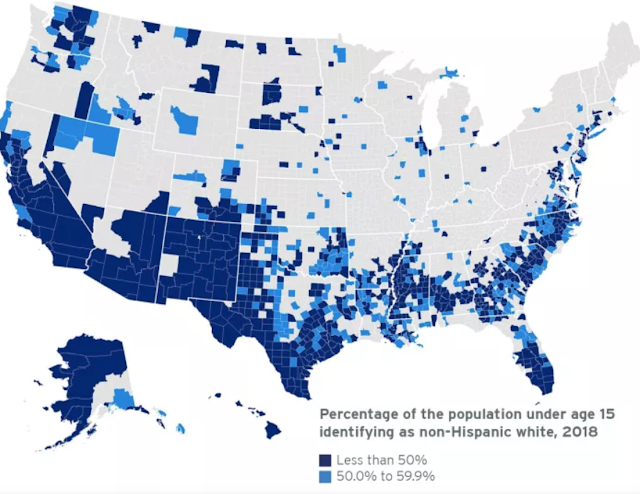
Adding to the shift of a more diverse population is the slowing down of the birthrate among Whites. It reflects an aging of the White population that has led to proportionately fewer women in their childbearing years. Census projections show White child losses for decades to come, with more young Whites aging past 15 than being born or immigrating to the U.S.
The browning of America will be bolstered by immigration. If current immigration rates continue, most of the new immigrants will be coming from Asia. They tend to be younger and more prolific, industrious and eager to give their families their share of the American dream.
Reports like the Brookings report raises the obvious point that institutions need to adjust their services to the needs of a new and more diverse population in education, health needs, training, businesses and marketing.
The Brookings report concludes: “These demographic trends make plain that, as racially diverse younger generations become part of the labor force, tax base, and consumer base, the nation will need to balance these groups’ distinct interests and needs in areas such as education, family services, and affordable housing with the health and social support requirements of a large and faster growing older population that will be entering its post retirement years.”
Beyond the world of statistics, we see real-world implications happening before our eyes.The wild-eyed violence we see at White supremacist rallies and (let’s be truthful) at Trump events too, is one way that the country can react, especially when they are goaded on by racist tweets from the White House and other conservative leaders. The most vocal of Trump’s supporters, afraid of losing their status and power — politically, economically and socially — are doing whatever they can to stop, or at the very least, slow the inevitable changes in the United States.
Short of a kumbaya moment, all of us — no matter what ethnic group we belong to — we have to find ways to make sure that transition from a majority White population to one that majority-minority is nonviolent and is smooth as possible. The give-and-take and push-and-pull that is sure to take place can be uncomfortable at times, but in the end, a new America will emerge. The future of the United States depends on how our country faces the greatest test since the Civil War — a nonviolent transition.
AsAmNews has Asian America in its heart. We’re an all-volunteer effort of dedicated staff and interns. Check out our Twitter feed and Facebook page for more content. Please consider interning, joining our staff or submitting a story

